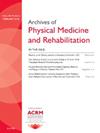A Novel Approach of Enhanced, Multidisciplinary Rehabilitation Services in the Hospital to Facilitate Home Discharge: The Rehab2Home Program
IF 3.6
2区 医学
Q1 REHABILITATION
Archives of physical medicine and rehabilitation
Pub Date : 2025-06-01
DOI:10.1016/j.apmr.2024.10.020
引用次数: 0
Abstract
Objective
To evaluate the effectiveness of an early, targeted, individualized, intensive rehabilitation program called Rehab2Home, designed to transition surgical patients directly from acute care to home.
Design
The Rehab2Home program was implemented using a quality improvement (QI) approach between March 2023 and June 2023. The outcomes of the program were compared with a historical cohort of similar patients.
Setting
Academic medical center.
Participants
Postsurgical patients (n=74) included were aged 18 years or older, recommended for subacute rehabilitation by physical therapy or occupational therapy, had some level of support at home, mild to no cognitive impairments, and moderate mobility impairments.
Interventions
Patients received an enhanced rehabilitation therapy program from physical therapy, occupational therapy, speech–language pathology, and consultations with a physiatrist emphasizing readiness for discharge home. The team also conducted weekday interdisciplinary huddles.
Main Outcome Measure(s)
The primary outcome for the evaluation of the program was discharge location from the hospital. Secondary outcomes included the length of hospital stay and emergency department visits and potentially avoidable utilization (PAU) within 30 days of hospital discharge.
Results
Seventy-four patients were included in the Rehab2Home program, with 66% discharging home compared to 47% in the historical controls. The program resulted in a 1.4 (95% CI, 1.1-1.6) times greater likelihood of discharging home and decreased the proportion of patients with potentially avoidable health care utilization by 63% (Risk Ratio: 0.37, 95% CI, 0.1-0.7), without a significant increase in length of stay (-0.6 days, 95% CI, -2.2 to 1.9).
Conclusions
The Rehab2Home program for postsurgical patients successfully facilitated home discharges and reduced postdischarge utilization. This model of rehabilitation shows promise for improving transitions of care from the hospital in this population.
一种在医院加强多学科康复服务以促进出院的新方法- Rehab2Home计划。
目的:评估名为Rehab2Home的早期、有针对性、个性化、强化康复计划的有效性,该计划旨在将外科患者直接从急性护理过渡到家庭。设计:Rehab2Home项目于2023年3月至2023年6月期间采用质量改进(QI)方法实施。将该项目的结果与历史上类似患者的队列进行比较。环境:学术医疗中心。参与者:术后患者(n=74)包括18岁或以上,推荐通过物理治疗或职业治疗进行亚急性康复,有一定程度的家庭支持,轻度至无认知障碍,中度活动障碍。干预措施:患者接受了强化的康复治疗方案,包括物理治疗、职业治疗、语言病理学和理疗师的咨询,强调出院回家的准备。该团队还在工作日举行了跨学科会议。主要结果测量:评估该方案的主要结果是出院地点。次要结局包括住院时间、急诊室就诊次数和出院后30天内潜在可避免利用率(PAU)。结果:74名患者被纳入Rehab2Home项目,其中66%出院,而历史对照组为47%。该方案使出院回家的可能性提高了1.4倍(95% CI: 1.1 - 1.6),并使潜在可避免医疗保健利用的患者比例降低了63%(风险比:0.37,95%CI: 0.1 - 0.7),住院时间没有显著增加(-0.6天,95%CI: -2.2 - 1.9)。结论:Rehab2Home项目成功地促进了术后患者的家庭出院,降低了出院后的使用率。这种康复模式显示了改善这一人群从医院转诊的希望。
本文章由计算机程序翻译,如有差异,请以英文原文为准。
求助全文
约1分钟内获得全文
求助全文
来源期刊
CiteScore
6.20
自引率
4.70%
发文量
495
审稿时长
38 days
期刊介绍:
The Archives of Physical Medicine and Rehabilitation publishes original, peer-reviewed research and clinical reports on important trends and developments in physical medicine and rehabilitation and related fields. This international journal brings researchers and clinicians authoritative information on the therapeutic utilization of physical, behavioral and pharmaceutical agents in providing comprehensive care for individuals with chronic illness and disabilities.
Archives began publication in 1920, publishes monthly, and is the official journal of the American Congress of Rehabilitation Medicine. Its papers are cited more often than any other rehabilitation journal.

 求助内容:
求助内容: 应助结果提醒方式:
应助结果提醒方式:


